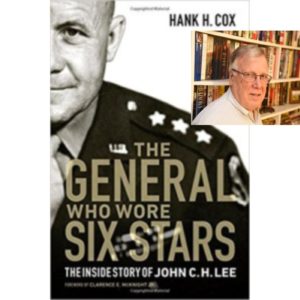Podcast: Play in new window | Download
Subscribe: RSS

Hank Cox has been writing in various capacities for many years. He’s written a book on the Sioux Uprising of 1862 and now on General JCH Lee of WWII.
1:39 – Hank Cox discusses how he got into writing history. He first wrote “Lincoln and the Sioux Uprising of 1862”. There hadn’t been much written on the subject in many decades.
3:27 – He’s also a big WWII fan and wanted to write about Lt. Gen. John C.H. Lee. Many of his colleagues didn’t like him though he was very successful being in charge of Army supplies in Europe.
5:03 – Lee did have unusual characteristics. He was very military and something of a martinet.
6:24 – The book goes into Lee’s pre WWII life. He fought in WWI and then joined the Corps of Engineers. He worked on the great Vicksburg flood of 1927. He developed many contacts that helped dictate what he ended up doing during WWII.
9:38 – Lee was put in charge of the great buildup of supplies in Great Britain for the invasion of Europe. One of the big issues was the train Lee wanted.
12:09 – Lee was also criticized heavily for being very religious and going to church often and his staff had to attend with him. He also didn’t have drinking buddies.
14:28 – He was also a strong advocate of African-American soldiers and thought they should be put to better use.
15:19 – Many of the US Generals in Europe also refused to be part of a centralized supply effort controlled by Lee.
16:42 – By the time of the Battle of the Bulge, the US was running out of troops and Lee changed the rules to allow black soldiers into combat. This bothered a lot of US Army leaders but Lee didn’t back down. White troops in the field accepted them at the time of combat.
18:38 – When Patton raced across Europe, the US supply lines weren’t in place to properly support him with fuel, food and ammo. Lee created the Red Ball Express – trucks driven mostly by black drivers racing across Europe to supply Patton.
20:26 – Lee moved his command into Paris when it was liberated. But Eisenhower had said Paris should only be for soldiers on leave. Lee argued that Paris was the central communications point across Europe and he had to put his headquarters there. Troops resented the great accommodations Lee and his staff had in Paris.
24:22 – Near the end of the war. Bradley and others refused to report how many supplies they had to Lee. The Germans also tried to attack US supply depots around Europe and Lee worked on removing all these supplies and out of the hands of the Germans.
26:33 – When Lee allowed black soldiers into combat, they had to lose rank to do that but thousands went into combat roles anyway.
27:40 – After the war, Lee was put in charge of Italy despite all the negative comments made about him.
31:18 – Lee has been unfairly criticized by historians as well. After the war he joined the Episcopalian group the Brotherhood of Saint Andrew.
33:08 – Benjamin Davis was sent over to allay fears of black soldiers and he became good friends with Lee.
34:30 – Lee had a large staff to run his operations. Twenty-five percent of US forces were in Lee’s command. But many of the combat forces refused to let supply people inventory their supplies.
37:03 – US generals were constantly stabbing each other in the back politically speaking.
38:49 – Lee was in charge of building air bases and supplying them but air force supply control was held by others. Lee requisitioned many air force personnel at times.
40:47 – Hank went to Carlisle for some historical records and also used Lee’s memoirs.
44:10 – Keeping track of and sourcing all the information in the book was the hardest part of writing it.
47:47 – Learning about the hardships the soldiers went through was the hardest thing to study while writing the book. Lee tried his hardest to get winter clothing to the soldiers in Bastogne and other areas. There was a lot of chaos in supplying soldiers.
51:03 – Omar Bradley was much more petty than Hank had expected and that bothered him. Omar Bradley has always been known as the GI’s General.
54:43 – Hank’s website is http://www.hankhcox.com/
Links
For more “Military History Inside Out” please follow me on Facebook at warscholar, on twitter at Warscholar, on youtube at warscholar1945 and on Instagram @crisalvarezswarscholar
Guests: Hank Cox
Host: Cris Alvarez
Tags: history, WWII, US Army, General Lee, supply history, US history, WWII history, Europe, non-fiction book, WW2, D-Day
